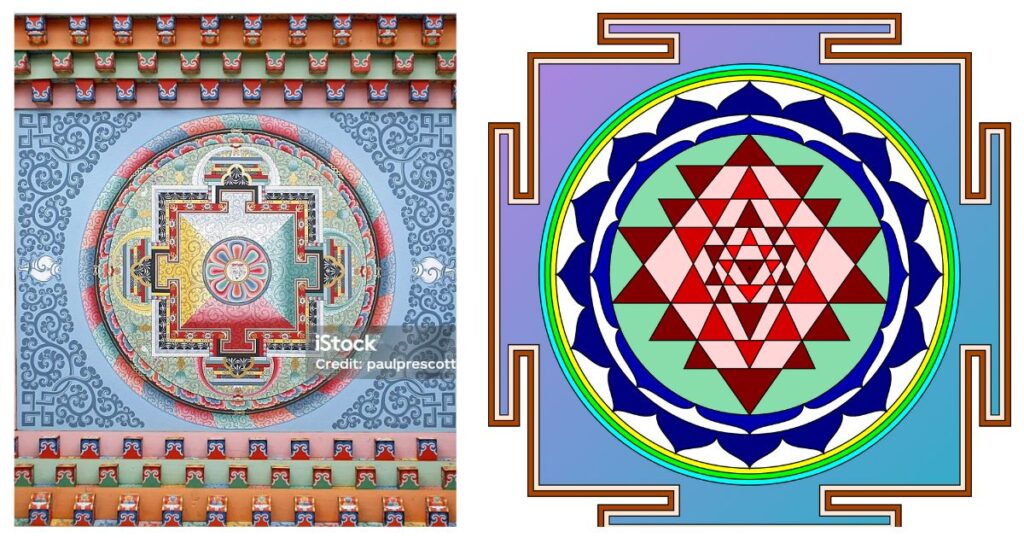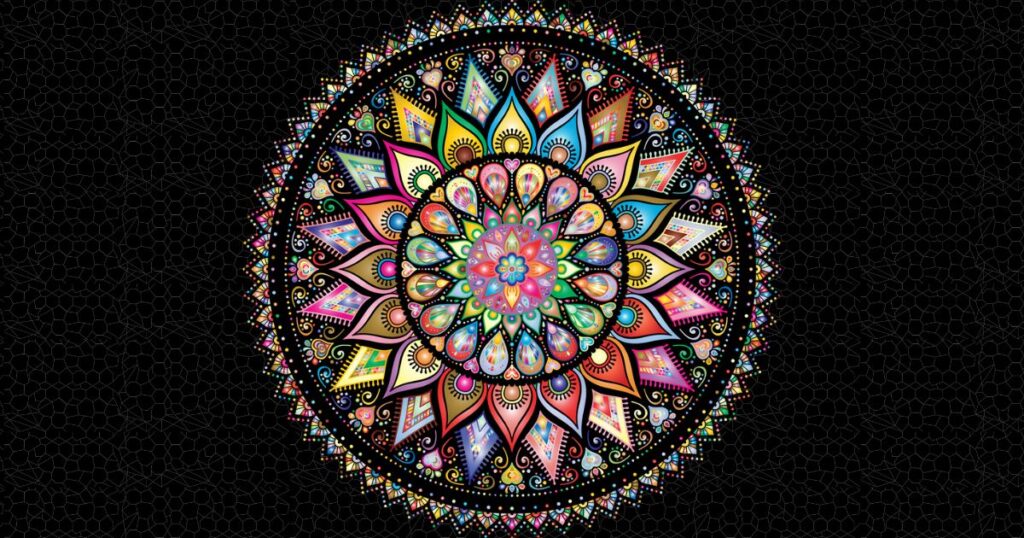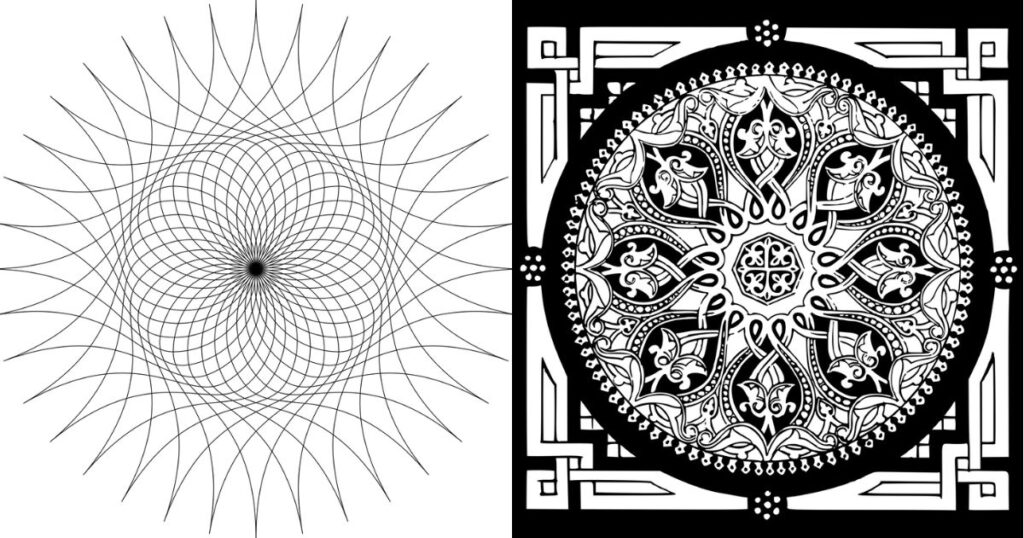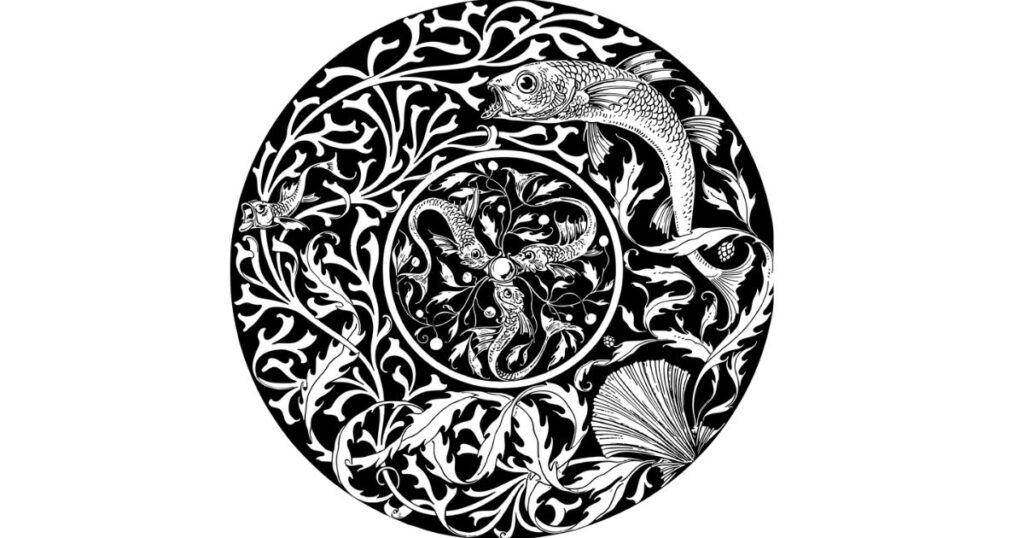Introduction
Mandalas, elaborate designs frequently crafted within a circular frame, are much more than just beautiful patterns. They are rich tapestries of symbolism, with each element thoughtfully picked to represent different aspects of the universe, the self, and the spiritual path. Let’s explore and discover the significance behind different elements of a mandala.
The Center: The Starting Point of Everything
The mandala unfolds from the center, often called the dot (bindu). This tiny but significant particle is the source, symbolizing the seed of possibility and the beginning of all things existential. It is the center that catches the viewer’s attention in the first gaze at the mandala. In spiritual terms, the center is frequently used as a focus point in meditation, representing the core of one’s existence or the essence of the divine. It is the singularity preceding the Big Bang, where everything initiates.

Symmetry and Geometry: The Blueprint of Order
Mandalas are famed for their symmetrical patterns. This symmetry serves more than simply aesthetic purposes; it signifies balance and harmony. Mandalas’ geometric accuracy and intricacy often reflect the hierarchical order of the universe. Consider the mandala to be a universe blueprint, with each form and pattern serving a purpose beyond beauty and producing a sense of balance and tranquility.
The Four Gates: Thresholds of Awareness
Four gates or gateways or portals, placed at the circle’s cardinal points, are a common feature in mandalas. The transition between the physical and spiritual realms is represented by these gates. These are consciousness thresholds, representing the mind’s openness to fresh viewpoints and dimensions. These gates are often guarded by deities in Buddhist mandalas, emphasizing the sacred character of the journey within.

Colors: The Spectrum of Experience
Colors in mandalas are not chosen at random; each hue carries a specific meaning and energy. They are like the playlist of your soul, each shade singing a different tune. Let’s dive into the rainbow symphony!
Red
Red is the drumbeat of passion, vigor, and energy. It represents power, courage, and vigor. In a mandala, red exclaims, “Feel alive!” It’s the hue of roots and grounding, connecting you to the very essence of existence.

Orange
Orange is the spark of creativity and joy. It symbolizes passion, achievement, and warmth. Consider this the mandala’s way of saying, “Let your imagination run wild!” It’s the color of the sacral chakra, which promotes pleasure and emotional harmony.

Yellow
Yellow is the color wheel’s happy color. It represents happiness, knowledge, and clarity. In a mandala, yellow glows, “Shine bright!” It is the color of the solar plexus chakra, which exudes confidence and personal strength.

Green
Green is nature’s hug. It represents development, harmony, and regeneration. In a mandala, green whispers, “Find your balance.” The color represents the heart chakra and promotes love and compassion.

Blue
Blue is a soothing melody of calm and truth. It symbolizes peace, knowledge, and communication. Blue gently states, “Breathe easy.” in a mandala. It is the hue of the throat chakra, which promotes honesty and expressiveness.

Purple
Purple represents the mystical muse of spirituality and intuition. It represents imagination, enlightenment, and cosmic connection. In a mandala, purple murmurs, “Explore the unseen.” It’s the hue of the head chakra, which connects you to greater consciousness.

Pink
Pink represents the gentle whisper of unconditional love and kindness. It symbolizes compassion, nurturing, and tenderness. In a mandala, pink coos, “Be gentle with yourself.” It’s the color that gives you a warm embrace.

White
White is a blank canvas of purity and innocence. It represents clarity, simplicity, and new beginnings. White echoes, “Start fresh.” in a mandala. This color represents unity and the divine.

Black
Black is a velvet cloak that exudes mystery and grandeur. It represents protection, power, and the unknown. In a mandala, black intrigues: “Embrace the unknown.” It is the hue of depth and introspection.

Rainbow
When all hues combine, it creates a symphony of harmony and balance. In a mandala, a rainbow cheers, “Celebrate Diversity!” It shows the highest expression of unity in diversity.

Shapes and Patterns: The Language of Symbols
Mandala shapes and designs function as a worldwide symbolic language. Each shape, line, and pattern conveys a hidden message about the universe, the mind, and the cycle of life. Let’s take a fun and quirky journey into this symbolic world.
Circles: The Hug of Infinity
Circles are the cozy hugs of the mandala world. The circle symbolizes union, entirety, and all things cyclical. Think of it as the cosmic embrace, wrapping everything in a never-ending loop. In a mandala, the circle frequently represents the cosmos, an infinite loop with no beginning or end, similar to the cycles of life and nature. It’s the cosmic womb, nurturing all within its bounds.

Squares: The Stable Foundations
Squares are like the four-legged chairs of stability. They represent structure, balance, and groundedness. In mandalas, squares often signify the four directions, elements, or stages of life. It’s like the mandala’s way of saying, “Stand firm, stay balanced.”

Triangles: The Dynamic Movers
Triangles are the arrows pointing the way. They stand for energy, transformation, and direction. Pointing upwards, triangles represent aspiration and the rise to the spiritual realms. Pointing downwards, they symbolize grounding and the flow of divine energy into the earth. It’s all about where the energy is headed.

Hexagons: The Sweet Harmony
Hexagons are the honeycombs of the mandala world. They symbolize harmony, balance, and the magic of nature’s efficiency. In mandalas, hexagons are like little beehives, buzzing with the energy of connectivity and cooperation. It’s the mandala’s way of saying, “Sweeten your life with unity and purpose.”

Spirals: The Journey Inward
Spirals are the dizzying dances of growth and evolution. They symbolize the journey from the outer world to the inner soul and vice versa. In mandalas, spirals can be like cosmic rollercoasters, taking you on a ride through life’s cycles and personal transformation.

Lotus Petals: The Bloom of Purity
Lotus petals are the delicate whispers of purity and enlightenment. Each petal represents a stage in the journey to spiritual awakening. In mandalas, lotuses are the bloom of the soul, rising above the muck to reach the sun. It’s like the mandala’s way of saying, “Keep blooming, no matter what.”

Lines and Borders: The Boundaries of the Universe
Lines and borders are the frames and connectors. Straight lines symbolize order and precision. Wavy lines represent the flow and flexibility. Zigzags? They’re the playful, unpredictable paths. Borders often set the sacred space, containing and protecting the mandala’s energy.

Grids: The Web of Life
Grids are the complex webs binding the universe. They signify interconnectedness and the intricate patterns of existence. In mandalas, grids can feel like the blueprints of reality, mapping out how everything is connected. It’s like a cosmic game of connect-the-dots. It represents the backbone of all mandalas.

Floral Patterns: The Garden of the Heart
Floral patterns are the heart’s garden in bloom. Flowers symbolize growth, beauty, and the ephemeral nature of life. In mandalas, they often represent the unfolding of inner beauty and the blossoming of the soul. Imagine a garden where each petal tells a story.

Stars, The Sun and The Moon: The Celestial Guides
Stars are the sparkling guides of the night sky. They symbolize hope, inspiration, and the divine. In mandalas, stars can be the twinkling signs leading the way through the darkness. It’s like having a celestial GPS.
The sun in a mandala serves as the cosmic cheerleader. It exudes energy, warmth, and vitality. Imagine it as the mandala’s way of saying, “Shine your light!” The sun represents vigor, enlightenment, and the ability to expand. It’s like having a small supernova right in the heart of your design, encouraging you to express your creativity and enthusiasm. Each beam communicates positivity and the message that every day is a new beginning.
The moon in a mandala serves as a calm night guidance. It represents intuition, dreams, and a peaceful flow of inner wisdom. Think of it as the mandala’s lullaby, gently singing, “Trust your inner glow.” The moon depicts cycles, symbolizing the rising and waning of life’s phases. It’s the quiet, reflective counterpart to the sun’s brilliance, encouraging introspection and emotional balance. In a mandala, the moon is like a soothing whisper, reminding you to find peace in the ebb and flow of life.

Animal Motifs: The Spirit Companions
Animal motifs represent the spirit companions of the mandala realm. Each animal has its own energy and symbolism. A lion may represent strength, an elephant- wisdom, a fish- fertility, or a bird- freedom. They are like small totem pals within the mandala, each offering guidance.

Mandalas Themselves: The Universe in a Snapshot, a Microcosm
Lastly, mandalas as a whole are microcosms of the universe. They symbolize the harmony and balance of all life. Every shape, pattern, and element comes together to create a sacred space for meditation and self-discovery. It’s like with each stroke, you’re holding the universe in your hands. When moving inward, you pass through the earthly realm and eventually reach the spiritual core. It’s like taking a journey from the outer edges of the galaxy right into the heart of the inner being.
Modern Mandalas: Art, Therapy, and Personal Growth
Today, mandalas are not confined to religious contexts. In today’s fast-paced world, mandalas continue to captivate and inspire people in new and unexpected ways: they have found their way into modern art, therapy, and personal growth practices. Coloring mandala books have become popular as a tool for stress relief and meditation.
Beyond the realm of spirituality, mandalas have influenced design, fashion, and pop culture. From intricate tattoos to stylish home decor, mandala-inspired motifs are everywhere. Their timeless appeal and universal symbolism resonate with people of all ages and backgrounds.

Conclusion: The Mandala's Endless Embrace
Mandalas are more than just beautiful patterns; they are profound symbols of the universe and our place within it. Every element of a mandala holds deep meaning, from the very center to the outermost circle. Each of them guides us on a journey of self-discovery and spiritual awakening. Whether used in traditional spiritual practices or modern therapeutic settings, mandalas remind us of life’s intricate, interconnected nature and the endless possibilities.
So next time you gaze at a mandala, remember, you’re not just looking at art. You’re peering into a cosmic map, a journey through the soul, and a playful dance of the universe. You will see each shape and design being a whisper from the cosmos, inviting you to explore the depths of your being.
FAQs: Unveiling the Meaning Behind Mandala Elements
What are some common mandala symbols and their meanings?
Many mandalas feature shapes like squares (representing the earthly realm) and circles (symbolizing the cosmos). Flowers often represent spiritual growth, while deities depict specific energies or aspects of the divine. Celestial objects present in the mandala may represent a guidance. Borders give protection to the internal sacred energy of the mandala and gates are present at cardinal points of the mandala to represent the presence of deities.
Can I create my own mandala and imbue it with personal meaning?
Absolutely! When we say mandalas are a tool for self-expression, self-exploration and self-discovery, this is what we mean. Mandala coloring books are trending for a reason. As you color shapes and symbols, focus on intentions or aspects of your life you want to cultivate.
Are mandalas connected to any particular religion?
While prominent in Hinduism and Buddhism, mandalas appear in various spiritual traditions. Their circular structure reflects the concept of wholeness found across many belief systems. The Mesoamerican Aztec Calendar, the Native American Dreamcatchers and Medicine Wheels, Hindu Yantras, geometric tiles in Islamic mosques, Chinese Yin-Yang, Christian Rosary, Roman interlace patterns later becoming Celtic Spirals or Celtic Knots are all examples of mandalas from a variety of cultures and beliefs.
I see mandalas with geometric patterns. What do they represent?
Geometric shapes like triangles and spirals can symbolize stability, movement, or spiritual ascent. Their precise placement within the mandala adds layers of meaning.
Can I use mandalas for meditation?
Yes! Focusing on the mandala’s central point helps quiet the mind and enter a meditative state. Gazing at the intricate patterns can be a powerful tool for inner exploration.
Are there different types of mandalas?
There sure are! Sand mandalas, a Tibetan Buddhist tradition, involve creating intricate designs from colored sand, only to be meticulously destroyed, symbolizing impermanence. Tibetan monks practice non-attachment with this ceremonial sand mandala creation.
Where can I find mandalas besides your blog?
Many cultures incorporate mandalas into their art and architecture. Explore places of worship, museums, or even nature! Even sitting where you are, just look around you. Once you know what a mandala is, you will see it everywhere from textiles, rugs, table runners, cushion covers, tattoos, to designer home decor items.
